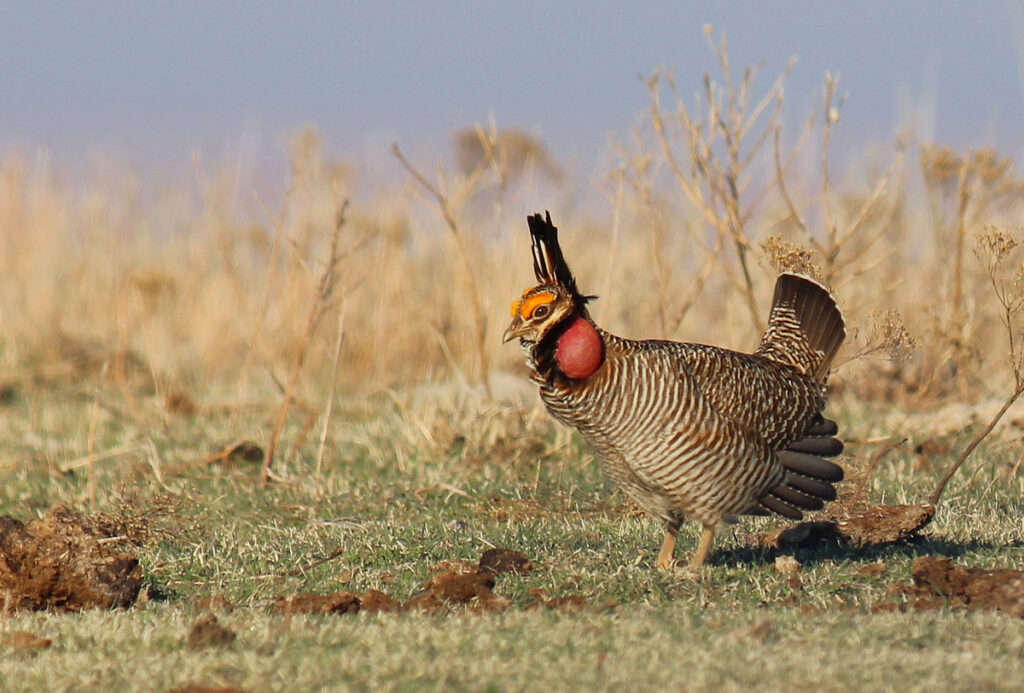
I had the pleasure of speaking with John Hayes of Audubon Southwest and Lindsay Larris of Wild Earth Guardians about their efforts to conserve and protect the Lesser Prairie-Chicken. This grouse once roamed across its habitat hundreds of miles wide, between Oklahoma, Texas, Kansas, Colorado, and New Mexico, but has seen a 90% reduction in their habitat over the past 100 years. As the American West expanded, oil and gas drilling, corn fields, and more recently wind farms, have all encroached on them.
The Lesser Prairie-Chicken once numbered in the millions and gave inspiration to the Niitsitapi (Blackfoot) and Nehiyawak (Cree) people for their “chicken dance,” which celebrates the relationship between people and the chicken, which was a staple food source for these tribes long before colonization. Today the chicken continues to inspire people across the world, thanks to viral videos of the male’s iconic mating dance, in which he balloons the red pouches on his neck, erects his antennae-like plumes, and furiously stomps the ground, jumps, flutters, and chirps for prospective mates.
Though grazing herds of cattle are negatively affecting the grasslands that these chickens call home, grazing animals can live in harmony with prairie chickens as they did for centuries: long before ranchers, wild buffalo herds roamed and grazed on the plains. The key, said Hayes, is “rotational grazing” that allows the grasslands to replenish during off seasons. Year-round grazing leads to depletion of habitat.
While wind energy is cleaner in terms of emissions produced, the huge structures instill fear into prairie chickens, as they detect places for predators to hide and strike from above. The Sagamore Wind Project in southern New Mexico was hailed upon its completion as a step forward for renewable energy, but Hayes noted that this project would not have gone forward had the prairie chicken been declared “endangered” by the Fish and Wildlife Service in 2014, rather than just “threatened.”
The protections offered by the “threatened” listing were reversed a year later when a Texas district court ruled in favor of Permian Basin Petroleum Association and found that the Fish and Wildlife Service acted “improperly” in declaring the Lesser Prairie-Chicken threatened, as they “failed to take into account” the efforts of ranchers and oil companies to conserve land for the grouse. Both conservationists I talked to lauded the individual efforts of ranchers and the cooperation of oil and gas companies, but both also flatly stated that “it’s not enough,” as the chicken hasn’t rebounded nearly enough despite these actions. As their population stands now, a bad drought or windstorm could wipe out the entire species.
Hayes explained that the Lesser Prairie-Chicken acts as a sort of “canary in the coal mine” for the overall health of grasslands at large. Larris explains that if an indicator species such as this goes extinct, it’s a warning of our heading toward another Dust Bowl. So what do they want to see done to protect this precious grouse? Hayes wants to see the Fish and Wildlife Service list the chicken as “endangered” and expand the area considered “impacted” by human development, and the federal government could send money to ranchers to help them improve their land and make it more hospitable to the chickens. Larris wants a proper “endangered” listing for the New Mexico and Colorado populations, and wants to see the funds and regulations behind the listing get implemented.
The good news is the past few years have shown a slight uptick in population. When I asked Hayes if he thought we’d ever see the prairie chicken return to its historic population of millions, he wasn’t optimistic, explaining that it would require the restoration of the entire Great Plains region. The goal is to have a “sustainable population” that can maintain itself in the face of extreme weather events. Larris was pleased with the proposed endangered listing from Fish and Wildlife, but again stressed the importance of following through on that with federal funds and on-the-ground implementation of protections.
Would you like to join in the efforts to protect the Lesser Prairie-Chicken and other endangered animals in New Mexico? Check out Audubon Southwest and Wild Earth Guardians. Audubon has a “bird-friendly beef” certification consumers can look for when buying meat to support ranchers participating in conservation efforts. Sign up for their email at nm.audubon.org. Wild Earth Guardians offers an action alert newsletter for litigation campaigns and public comment periods pertaining to endangered and threatened New Mexico animals: sign up at wildearthguardians.org.
Author
-

Bryce Flanagan moved from Sacramento, CA to Taos County in 2016, and has lived in Questa for two years. He's passionate about the unique and beautiful wildlife of our state and is a regular contributor to the Questa Del Rio News.
View all posts


